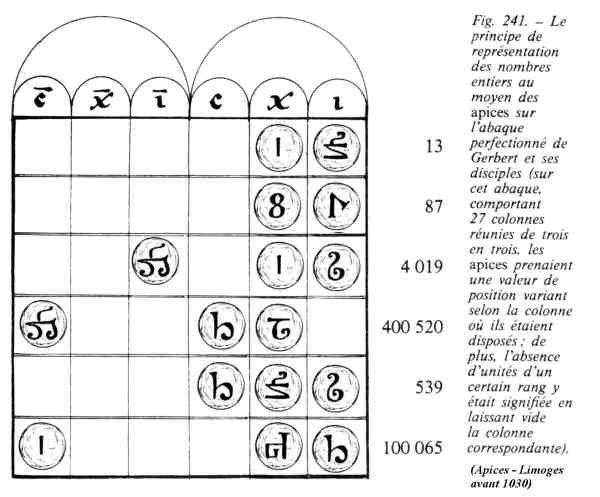- About MAA
- Membership
- MAA Publications
- Periodicals
- Blogs
- MAA Book Series
- MAA Press (an imprint of the AMS)
- MAA Notes
- MAA Reviews
- Mathematical Communication
- Information for Libraries
- Author Resources
- Advertise with MAA
- Meetings
- Competitions
- Programs
- Communities
- MAA Sections
- SIGMAA
- MAA Connect
- Students
- MAA Awards
- Awards Booklets
- Writing Awards
- Teaching Awards
- Service Awards
- Research Awards
- Lecture Awards
- Putnam Competition Individual and Team Winners
- D. E. Shaw Group AMC 8 Awards & Certificates
- Maryam Mirzakhani AMC 10 A Awards & Certificates
- Two Sigma AMC 10 B Awards & Certificates
- Jane Street AMC 12 A Awards & Certificates
- Akamai AMC 12 B Awards & Certificates
- High School Teachers
- News
You are here
Gerbert d'Aurillac and the March of Spain: A Convergence of Cultures - Gerbert's Abacus
Gerbert devised a new kind of abacus which one could use to calculate with the Hindu numerals, a flat board with columns drawn on it, corresponding to ones, tens, hundreds, and so forth. (Some scholars believe he may have been the first person to use the Latin term abacus.) He had a shield-maker construct small pieces of animal horn with the numerals on them; called apices, the pieces could then be placed on the board to represent numbers. A zero was not necessary; the absence of a marker in the tens’ place, for instance, meant that there were no tens. An eleventh-century manuscript found in Limoges illustrates the representation of numbers on such an abacus. (Note that the numerals had changed slightly in the next hundred years.)

Gerbert compiled a list of rules for computing with his abacus, Regula de Abaco Computi, in which he painstakingly explained how to multiply and divide, as well as add and subtract, in the new system. A companion work, Liber Abaci, by his student Bernelin, is often included in the collected works of Gerbert; it predates the book of the same name by Fibonacci by two hundred years.
To see an example of how to add numbers using Gerbert’s abacus, download the PowerPoint file, Adding Two Numbers on Gerbert's Abacus.
And for an example of subtraction, download the PowerPoint file, Subtracting with Gerbert's Abacus.
Betty Mayfield (Hood College), "Gerbert d'Aurillac and the March of Spain: A Convergence of Cultures - Gerbert's Abacus," Convergence (August 2010)




